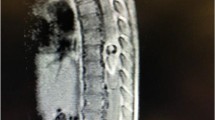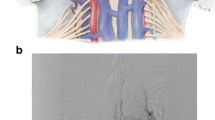Abstract
Object
While it has been extensively studied in adults, the role of spinal angiography in children with suspected spinal vascular malformations is not fully characterized. With special implications regarding technique, radiation dose, and pathology, we sought to review our single-center experience with pediatric spinal vascular pathology and use a systematic review of the literature to further identify its role in pediatrics.
Methods
A retrospective chart review was conducted under IRB approval for all patients age 0–18 years old who underwent spinal angiography at our institution between 2007 and 2018 for concern for spinal vascular pathology. A simultaneous systematic review was conducted via dedicated search terms in two distinct databases and reviewed to identify all studies referring to spinal angiography or angiograms in pediatric patients.
Results
Six patients were included. Three patients (50%) had vascular malformations confirmed on diagnostic angiography and underwent subsequent endovascular treatment. Two patients (33.3%), one with hematomyelia and one with spinal cord infarction, had negative diagnostic angiograms. One patient (16.7%) had a spinal tumor and underwent angiography for further evaluation preoperatively. Spinal angiography was used to aid in diagnosis, preoperative planning, and treatment in these cases. It was demonstrated to be safe in this patient population, with no untoward events, minimal radiation dose, and possible therapeutic applications in select cases. The systematic review identified 11 studies regarding pediatric spinal angiography. These ranged from single case reports to case series of up to 38 patients and highlighted the role of spinal angiography in diagnosis, endovascular treatment, preoperative planning, and postoperative follow-up.
Conclusions
Spinal angiography may be used in a variety of scenarios to better understand the architecture of vascular spinal lesions and facilitate endovascular intervention. While its application in both adult and pediatric pathology is limited to select cases, spinal angiography remains a key diagnostic procedure when approaching vascular lesions or tumors of the spine, assessing for etiology of spinal cord infarcts, and in the evaluation of unexplained hemorrhage in the spinal canal.


Similar content being viewed by others
References
Chen J, Gailloud P (2011) Safety of spinal angiography: complication rate analysis in 302 diagnostic angiograms. Neurology 77:1235–1240. https://doi.org/10.1212/WNL.0b013e3182302068
dos Santos MP, Zhang J, Ghinda D et al (2015) Imaging diagnosis and the role of endovascular embolization treatment for vascular intraspinal tumors. Neurosurg Focus 39:E16. https://doi.org/10.3171/2015.5.FOCUS1514
El Mekabaty A, Pardo CA, Gailloud P (2017) The yield of initial conventional MRI in 115 cases of angiographically confirmed spinal vascular malformations. J Neurol 264:733–739. https://doi.org/10.1007/s00415-017-8419-x
Harbron RW, Chapple C-L, O’Sullivan JJ, Best KE, Berrington de González A, Pearce MS (2017) Survival adjusted cancer risks attributable to radiation exposure from cardiac catheterisations in children. Heart 103:341–346. https://doi.org/10.1136/heartjnl-2016-309773
Hudson MM (2010) Reproductive outcomes for survivors of childhood cancer. Obstet Gynecol 116:1171–1183. https://doi.org/10.1097/AOG.0b013e3181f87c4b
Kalani MYS, Ahmed AS, Martirosyan NL, Cronk K, Moon K, Albuquerque FC, McDougall CG, Spetzler RF, Bristol RE (2012) Surgical and endovascular treatment of pediatric spinal arteriovenous malformations. World Neurosurg 78:348–354. https://doi.org/10.1016/j.wneu.2011.10.036
Kitagawa RS, Mawad ME, Whitehead WE, Curry DJ, Luersen TG, Jea A (2009) Paraspinal arteriovenous malformations in children. J Neurosurg Pediatr 3:425–428. https://doi.org/10.3171/2009.2.PEDS08427
Kleinerman RA (2006) Cancer risks following diagnostic and therapeutic radiation exposure in children. Pediatr Radiol 36:121–125. https://doi.org/10.1007/s00247-006-0191-5
Kobayashi E, Awa H, Asakura T (1977) Surgical treatment of the thoracic arteriovenous malformations with intraspinal and extraspinal niduses. Neurol Surg 5:647–653
Kreppel D, Antoniadis G, Seeling W (2003) Spinal hematoma: a literature survey with meta-analysis of 613 patients. Neurosurg Rev 26:1–49. https://doi.org/10.1007/s10143-002-0224-y
Lin N, Smith ER, Scott RM, Orbach DB (2015) Safety of neuroangiography and embolization in children: complication analysis of 697 consecutive procedures in 394 patients. J Neurosurg Pediatr 16:432–438. https://doi.org/10.3171/2015.2.PEDS14431
Meng X, Zhang H, Wang Y, Ye M, He C, du J, Ling F (2010) Perimedullary arteriovenous fistulas in pediatric patients: clinical, angiographical, and therapeutic experiences in a series of 19 cases. Childs Nerv Syst ChNS Off J Int Soc Pediatr Neurosurg 26:889–896. https://doi.org/10.1007/s00381-009-1071-8
Nordin AB, Fallon SC, Jea A, Kim ES (2013) The use of spinal angiography in the management of posterior mediastinal tumors: case series and review of the literature. J Pediatr Surg 48:1871–1877. https://doi.org/10.1016/j.jpedsurg.2013.04.029
Orru’ E, Sorte DE, Gregg L, Wolinsky JP, Jallo GI, Bydon A, Tamargo RJ, Gailloud P (2017) Intraoperative spinal digital subtraction angiography: indications, technique, safety, and clinical impact. J NeuroInterventional Surg 9:601–607. https://doi.org/10.1136/neurintsurg-2016-012467
Partanen M, Bouffet E, Laughlin S, Strother D, Hukin J, Skocic J, Szulc-Lerch K, Mabbott DJ (2018) Early changes in white matter predict intellectual outcome in children treated for posterior fossa tumors. NeuroImage Clin 20:697–704. https://doi.org/10.1016/j.nicl.2018.09.005
Reeves AG, Swenson RS (2008) Chapter 27: Cerebrovascular disorders. In: Disorders of the Nervous System: A Primer. Imperial Company Printers, Hanover, NH. https://www.dartmouth.edu/~dons/part_3/chapter_27.html. Accessed 30 March 2019
Rodesch G, Lasjaunias P (2003) Spinal cord arteriovenous shunts: from imaging to management. Eur J Radiol 46:221–232
Saliou G, Tej A, Theaudin M, Tardieu M, Ozanne A, Sachet M, Ducreux D, Deiva K (2014) Risk factors of hematomyelia recurrence and clinical outcome in children withiIntradural spinal cord arteriovenous malformations. Am J Neuroradiol 35:1440–1446. https://doi.org/10.3174/ajnr.A3888
Soltanolkotabi M, Schoeneman SE, Alden TD, Hurley MC, Ansari SA, DiPatri AJ, Tomita T, Shaibani A (2013) Onyx embolization of intracranial arteriovenous malformations in pediatric patients. J Neurosurg Pediatr 11:431–437. https://doi.org/10.3171/2013.1.PEDS12286
Wallace WHB, Thomson AB, Kelsey TW (2003) The radiosensitivity of the human oocyte. Hum Reprod 18:117–121. https://doi.org/10.1093/humrep/deg016
Wasilewski-Masker K, Seidel KD, Leisenring W, Mertens AC, Shnorhavorian M, Ritenour CW, Stovall M, Green DM, Sklar CA, Armstrong GT, Robison LL, Meacham LR (2014) Male infertility in long-term survivors of pediatric cancer: a report from the childhood cancer survivor study. J Cancer Surviv Res Pract 8:437–447. https://doi.org/10.1007/s11764-014-0354-6
Author information
Authors and Affiliations
Corresponding author
Ethics declarations
Conflict of interest
The authors declare that they have no conflict of interest.
Additional information
Publisher’s note
Springer Nature remains neutral with regard to jurisdictional claims in published maps and institutional affiliations.
No part of this work has been previously published.
Rights and permissions
About this article
Cite this article
Goethe, E., LoPresti, M.A., Kan, P. et al. The role of spinal angiography in the evaluation and treatment of pediatric spinal vascular pathology: a case series and systematic review. Childs Nerv Syst 36, 325–332 (2020). https://doi.org/10.1007/s00381-019-04329-3
Received:
Accepted:
Published:
Issue Date:
DOI: https://doi.org/10.1007/s00381-019-04329-3




